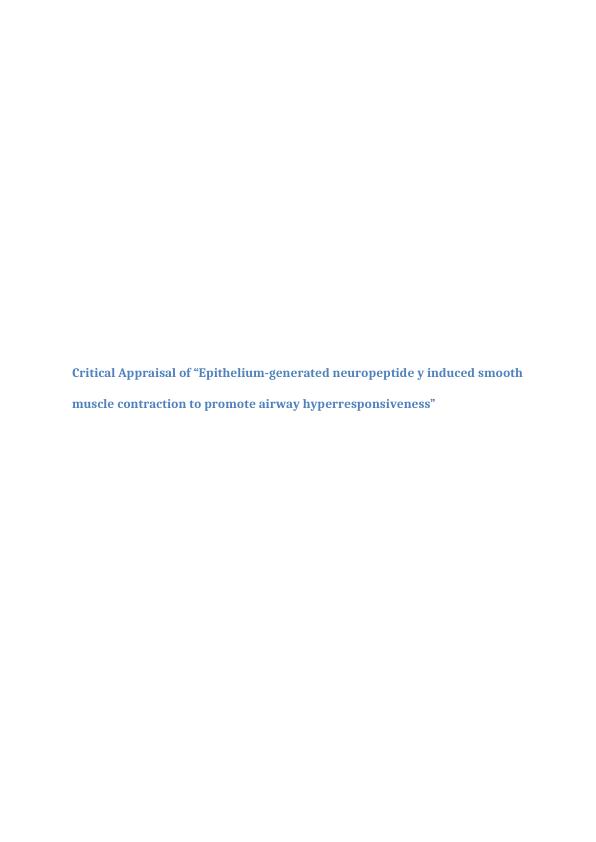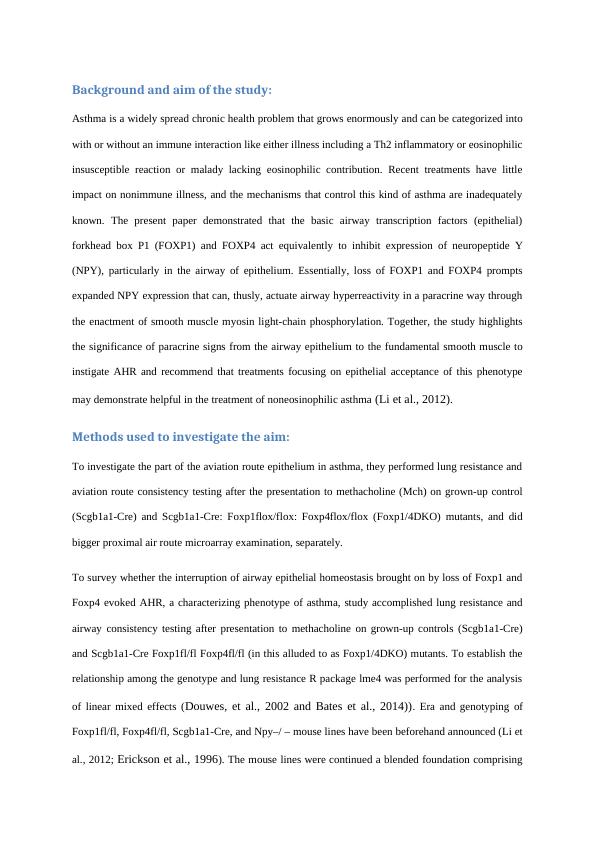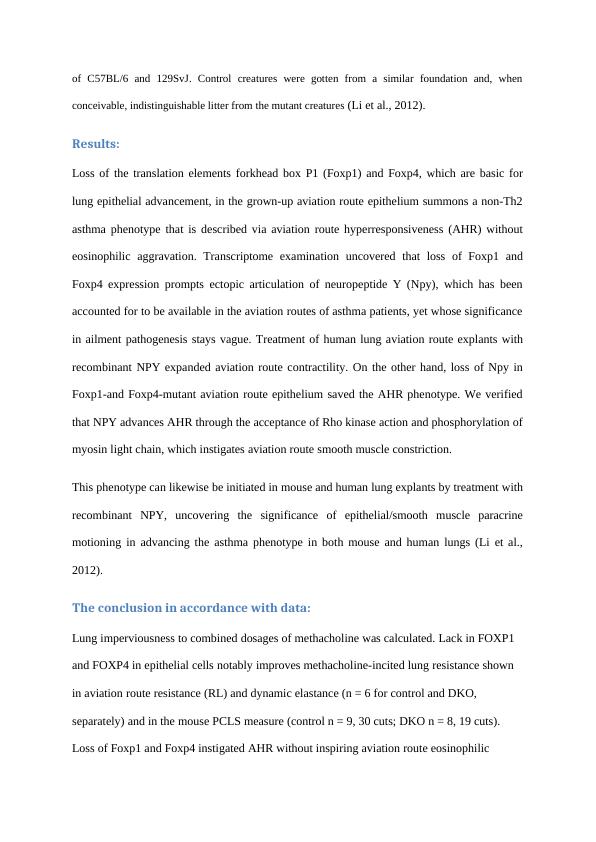Ask a question from expert
Study on Asthma- Doc
7 Pages1594 Words457 Views
Added on 2019-09-16
Study on Asthma- Doc
Added on 2019-09-16
BookmarkShareRelated Documents
Critical Appraisal of “Epithelium-generated neuropeptide y induced smoothmuscle contraction to promote airway hyperresponsiveness”

Background and aim of the study: Asthma is a widely spread chronic health problem that grows enormously and can be categorized intowith or without an immune interaction like either illness including a Th2 inflammatory or eosinophilicinsusceptible reaction or malady lacking eosinophilic contribution. Recent treatments have littleimpact on nonimmune illness, and the mechanisms that control this kind of asthma are inadequatelyknown. The present paper demonstrated that the basic airway transcription factors (epithelial)forkhead box P1 (FOXP1) and FOXP4 act equivalently to inhibit expression of neuropeptide Y(NPY), particularly in the airway of epithelium. Essentially, loss of FOXP1 and FOXP4 promptsexpanded NPY expression that can, thusly, actuate airway hyperreactivity in a paracrine way throughthe enactment of smooth muscle myosin light-chain phosphorylation. Together, the study highlightsthe significance of paracrine signs from the airway epithelium to the fundamental smooth muscle toinstigate AHR and recommend that treatments focusing on epithelial acceptance of this phenotypemay demonstrate helpful in the treatment of noneosinophilic asthma (Li et al., 2012).Methods used to investigate the aim: To investigate the part of the aviation route epithelium in asthma, they performed lung resistance andaviation route consistency testing after the presentation to methacholine (Mch) on grown-up control(Scgb1a1-Cre) and Scgb1a1-Cre: Foxp1flox/flox: Foxp4flox/flox (Foxp1/4DKO) mutants, and didbigger proximal air route microarray examination, separately.To survey whether the interruption of airway epithelial homeostasis brought on by loss of Foxp1 andFoxp4 evoked AHR, a characterizing phenotype of asthma, study accomplished lung resistance andairway consistency testing after presentation to methacholine on grown-up controls (Scgb1a1-Cre)and Scgb1a1-Cre Foxp1fl/fl Foxp4fl/fl (in this alluded to as Foxp1/4DKO) mutants. To establish therelationship among the genotype and lung resistance R package lme4 was performed for the analysisof linear mixed effects (Douwes, et al., 2002 and Bates et al., 2014)). Era and genotyping ofFoxp1fl/fl, Foxp4fl/fl, Scgb1a1-Cre, and Npy–/ – mouse lines have been beforehand announced (Li etal., 2012; Erickson et al., 1996). The mouse lines were continued a blended foundation comprising

of C57BL/6 and 129SvJ. Control creatures were gotten from a similar foundation and, whenconceivable, indistinguishable litter from the mutant creatures (Li et al., 2012).Results: Loss of the translation elements forkhead box P1 (Foxp1) and Foxp4, which are basic forlung epithelial advancement, in the grown-up aviation route epithelium summons a non-Th2asthma phenotype that is described via aviation route hyperresponsiveness (AHR) withouteosinophilic aggravation. Transcriptome examination uncovered that loss of Foxp1 andFoxp4 expression prompts ectopic articulation of neuropeptide Y (Npy), which has beenaccounted for to be available in the aviation routes of asthma patients, yet whose significancein ailment pathogenesis stays vague. Treatment of human lung aviation route explants withrecombinant NPY expanded aviation route contractility. On the other hand, loss of Npy inFoxp1-and Foxp4-mutant aviation route epithelium saved the AHR phenotype. We verifiedthat NPY advances AHR through the acceptance of Rho kinase action and phosphorylation ofmyosin light chain, which instigates aviation route smooth muscle constriction.This phenotype can likewise be initiated in mouse and human lung explants by treatment withrecombinant NPY, uncovering the significance of epithelial/smooth muscle paracrinemotioning in advancing the asthma phenotype in both mouse and human lungs (Li et al.,2012).The conclusion in accordance with data:Lung imperviousness to combined dosages of methacholine was calculated. Lack in FOXP1 and FOXP4 in epithelial cells notably improves methacholine-incited lung resistance shown in aviation route resistance (RL) and dynamic elastance (n = 6 for control and DKO, separately) and in the mouse PCLS measure (control n = 9, 30 cuts; DKO n = 8, 19 cuts). Loss of Foxp1 and Foxp4 instigated AHR without inspiring aviation route eosinophilic

End of preview
Want to access all the pages? Upload your documents or become a member.